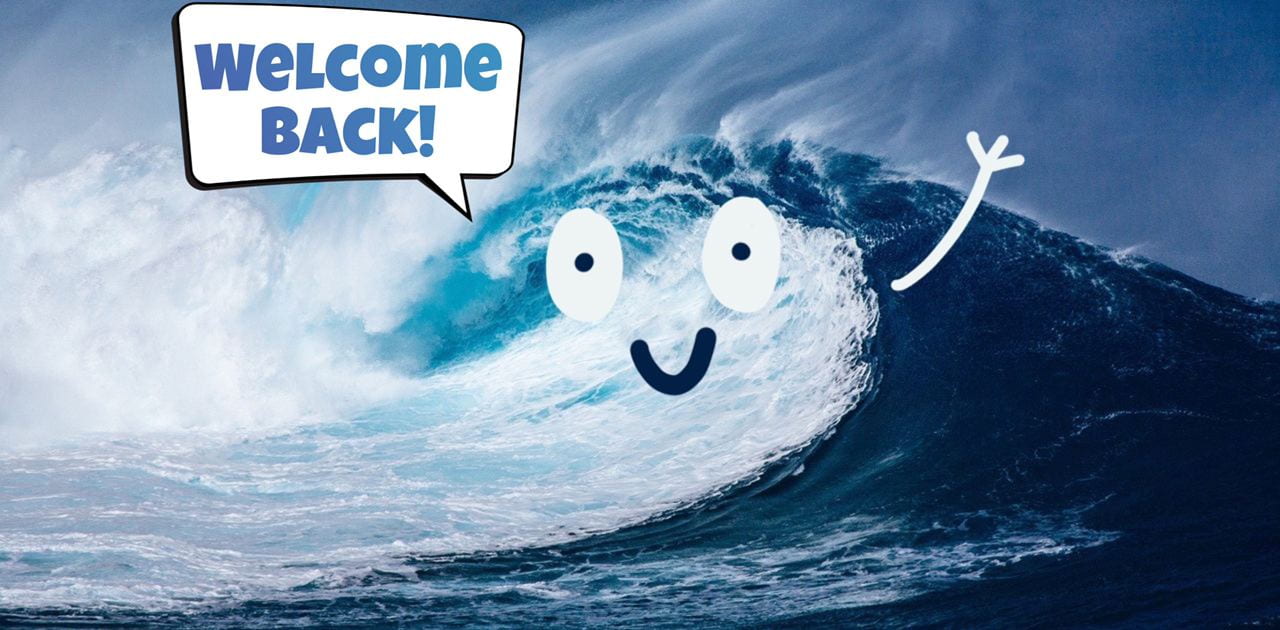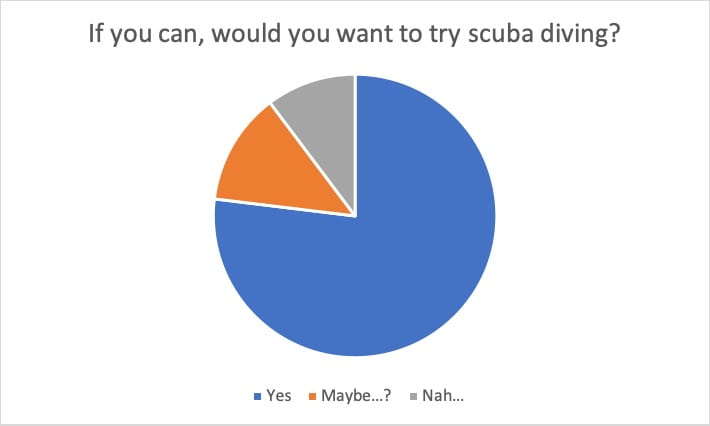Hello again, and I hope all of you have been doing great ever since the introduction!
Over the course of the week, I thought about how I wanted to structure my blog and figured that I would present it as if you were experiencing a new scuba diving adventure. This was actually inspired by the survey I conducted, with the results shown below. And I really hope this blog would provide the push and inspiration to actually try something new.
I mean, you only live once, right?
And it’s true, because imagine having to sign a waiver at 13 just to dive. This was also when I realized the necessity of preparing yourself and knowing what you sign up for. Hence, in today’s blog, I have decided to cover how the history of marine conservation ties in with current practices that have been put in place today to ensure that both you and the environment stay safe.
For anything deemed “extreme”, a long list of Do’s and Don’ts follow, and scuba diving is no exception, as illustrated in the infographic below.
Did you notice that “Don’t Touch” appear twice? That’s simply because the environment’s a lot more fragile than we thought and could prove dangerous too.
So how did all this come about?
As compared to terrestrial conservation, which was said to have begun during the period of rapid industrialisation (some argue it took place even earlier), the idea of marine conservation only surfaced from World War II, thanks to Jacques Cousteau, one of the few world-renowned pioneers who kickstarted the whole movement.

Jacques Cousteau, inventor, filmmaker, photographer and conservationist (Image from Wikimedia Commons under Creative Commons Attribution – CC0 1.0 Universal (CC0 1.0) Public Domain Dedication license.)
He was known for many things, but what he is probably most well-known for would be the invention of the diving regulator, which he did with Emile Gagnan. Without this, all of us wouldn’t have been able to spend more than 5 minutes admiring the underwater world.
With all that knowledge and exposure, it wouldn’t come as a surprise that he was one of those who contributed to the stopping of commercial whaling (which also inspired the US to embark on marine conservation) and the dumping of harmful chemicals into the deep blue. All that took place in the 1950s, and now, it’s safe to say that marine conservation has officially become a global movement, with laws regulating marine pollution, areas cordoned off to conserve biodiversity, social media campaigns (#SaveOurOceans), businesses who have dedicated themselves to raising awareness, and NGOs providing education. It might seem like a business ploy to some, but it’s heartening to know there is at least something propelling this idea forward.
Ending with a diver’s opinion, there are times when we don’t mean to “destroy” the environment, because in times of strong currents, all you can do is hold on or risk being swept away (I got stung by a soft coral once because of this and believe me, it hurts). However, when you find yourself compelled to touch something instead, perhaps this clip from Finding Dory might put things into perspective.






Hey Natasha!
Firstly, LOVE YOUR BLOG. The whole theme, your edits on the photos, all very cute.
This post was actually really eye opening for me! I want to dive at least once, but I never really thought much about the dangers it posed. The sea is filled with so much unknown huh!
Speaking of the unknown, are you considering discussing deep sea organisms in your blog? There’s so much weirdness going on down there!
Looking forward to your future posts!
Anna
Hi Anna! Thank you for your comment because it does mean a lot coming from someone who’s extremely artistic too! I’m really happy you’ve been enjoying the content so far, and the fact that I was able to provide an insight as to what diving’s like. To be frank, all extreme sports have their dangers, but if you’re careful, everything will be fine! I’ve had my fair share of encounters with dangerous marine life, including the toxic blue ring octopus (which kills a man in 90 minutes), and yet, I’m still alive (which is a relief, because I’m pretty clumsy on land)! I hope that didn’t scare you, because as long as you are friendly, they’ll be friendly too! If you’d like to get an actual experience, perhaps we could head down to the annual Asia Dive Expo one day, or perhaps you might want to join me in considering the NUS Dive Club as a CCA? I’d be happy to have you with me!
As for the discussion on deep sea organisms, I was thinking about it, because I find them fascinating too. Here’s one of my favourite (short) videos for them! Even though we can’t get there (unless you are in a submarine), I’d love to look more into it! We know the surface isn’t doing so well, but did you know that this extends to the deep sea too? With warming oceans, this means that there will be less food, less oxygen, and less calcium carbonate for deep sea corals to regenerate… The list goes on, and here’s a link for more information! I hope this wasn’t too long though, and besides, there’s possibly a whole blog post to look forward to anyway! I’ll hope to see you then!
Hey Natasha!
The video was super interesting! Thanks for the links and info, its really disheartening that even the deep sea, a place humans can barely reach, is still affected by our actions far above 🙁
I’ve heard of the NUS diving cca actually! Maybe in the future I’ll ask you for a jio ahah.
Anna 😀
Hi Anna! I’m glad you enjoyed the links and info I provided, and I have to agree that it’s a pity that we are adversely affecting places that are said to be “untouchable”. In fact, as I had mentioned in my introductory post, it’s saddening how we know so little about our ocean (i.e. we only know less than 10% of what’s living in it) and yet, we aren’t doing much to help ourselves either, given that marine pollution is still a very real thing today. Nevertheless, I cannot help but feel like there is a light at the end of the tunnel, or at least I’d simply love to think so, because with so much exposure now, it’s hard not to know about or feel anything for these creatures anymore. Hopefully, that will spark a change in time to come, and we could always start with ourselves first before spreading awareness and sharing the information to others. It might not be big changes, but it’s something, and even that can change things for the better.
And with regards to the jio, of course! I’m not sure when I’ll join the CCA though, but it’ll definitely be something that I hope to be a part of quite soon! I’ll be looking forward to that and if you have anything to ask with regards to diving, simply send me a message on telegram! I’d be more than happy to provide!
Hi Natasha!
Wow that was a great blog post! I was particularly blown away by all the contributions made by Jacques Cousteau, he sounds like a passionate marine lover! Its good to know that there policies and movements that help protect marine life!
I hope to try out diving one day in the future! It sounds like a unique experience!! I’m curious about those oxygen tanks that divers carry during their dive, how heavy are they? I remember having to heft them about during my time as an SAF medic and i recall they were pretty heavy, is it difficult to swim with them strapped on your back?
Hi Joseph! Thank you for your comment and I’m glad that I was able to share the insight that I got with regards to how conservation of the deep blue spurred in the first place. In fact, it was all thanks to Dr Coleman who mentioned him during a consult, and truth be told, even I was fascinated by his contributions, especially when I came to know that he was half of the masterminds of a scuba diver’s most important equipment – the diving regulator (it’s literally our lifeline). Of course, his contributions to marine life did not go unnoticed, and not only was he initiating such movements in person, he also spread the knowledge by releasing acclaimed books and films, which you can read more about here. Oh, and not to mention that it’s so inspiring to have read how he dedicated his whole life to this one cause, and I aspire to have that level of commitment too.
Onto your question about the air tanks (we don’t use the term oxygen tank because it gives a false idea of its components, as it contains nitrogen, oxygen and inert gases – pretty much in the same ratio as our atmosphere and here’s some interesting facts about the tanks we use), they weigh about 5kg each. For me in particular, given that I don’t have much upper body strength to begin with, it was difficult to carry them, especially for shore dives (i.e. you enter the water from the shore) and I’ve fallen many, many times (on hard rock too), but once you start diving, it becomes completely weightless and frankly, you often forget about the number of devices you have strapped to you. That’s actually why I like diving so much – it’s one of the few opportunities you can actually feel completely free.